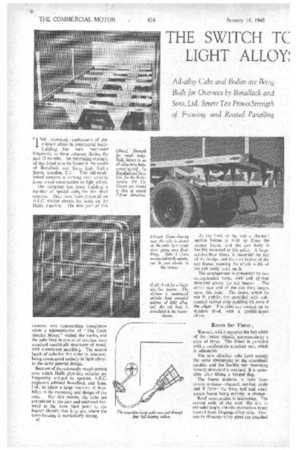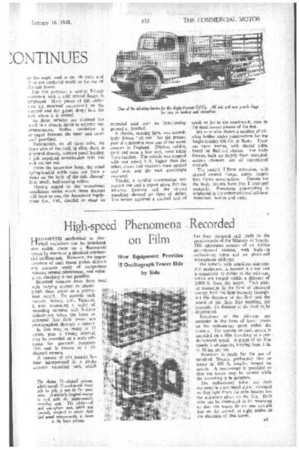THE SWITCH TC LIGHT ALLOY
Page 36

Page 37

If you've noticed an error in this article please click here to report it so we can fix it.
,ONTINUES THE increasing employment of aluminium alloys in commercial bodybuilding has been mentioned frequently in these columns during the past 12 months. An interesting example of this trend is to be found in the works of Bonallack and Sons, Ltd., Cable Street, London, E.7. This old-established concern is turning over steadily from wood construction to light alloys.
The company has been building a number of special cabs, for the Shell
concern. They have been mounted on•A.E.C. tractor chassis for work on the Haifa pipe-line. The first part of this
contract was approaching completion when a representative of "The Commercial Motor" visited the works, and the cabs then in course of erection were standard coachbuilt structures of wood, with aluminium panelling. The second ' batch of cabs for this order is, however, being constructed entirely in light alloys, to the same general design.
Because of the extremely rough terrain over which Haifa pipe-line vehicles are frequently obliged to operate, A.E.C. engineers advised Bonallack and Sons, Ltd., to allow a large measure of flexibility in the mounting and design of the cabs. For this reason, the cabs are articulated at the rear and anchored forward at the most rigid point in the tractor chassis; that is to say, where the cross-bracing is particularly strong. a2 At the back of the cab a channelsection bridge is built up from the tractor frame, and the cab body is flexibly mounted at this point. A large, solid-rubber block is mounted on top of the bridge, and the rear bearer of the cab frame, running the whole width of the cab body, mts on it.
The arrangement is completed by two spring-loaded bolts, with coil springs mounted above the cab bearer. The entire rear end of the cab thus hinges upon this point. The doors, which do not fit tightly, are provided with substantial rubber strip padding all around the edges. The sides are vertical up to window level, with a tumble-home above.
Room for Three;
The cab, which occupies the full width of the tractor chassis, accommodates a crew of three. The driver is provided with a comfortable armchair seat, which is adjustable.
The new all-alloy cabs have exactly the same dimensions as the coachbuilt models, and the flexible rear mounting already described is tetained. It is accessible after lifting a hinged flap.
The frame skeleton is built from robust sections—channel, top-hat, angle and T form—the front end and windscreen frame being entirely in channel.
Roof constru:tion is interesting. The curved ends of the roof ribs are in extruded angle, the ribs themselves being formed from 14-gauge alloy strip. Gussets in 10-gauge alloy plate are attached to the angle used at the rib ends, and these are anchored neatly to the top of the cab frame.
For this purpose, a special T-form extrusion, with a split central flange, is employed. Short pieces of this extrusion are mounted transversely on the cantrail and the gusset drops into the slot, where it is riveted.
As these vehicles are destined for work in a climate liable to extreme sun temperatures. Isoflex insulation is arranged between the inner and outer roof panelling.
Incidentally, on all these cabs, the inner skin of the roof, in alloy sheet, is mounted directly, without panel beating, a job requiring considerable skill, but well carried out.
From the inspection lamp, the usual spring-loaded cable runs out from a point on the back of the cab, through four small, ball-bearing rollers.
Having regard to the exceptional conditions under which these tractors will have to run, the Associated Equipment Co., Ltd,, decided to stage an extended trial over its Tank-testing ground at Southall.
A chassis, running light, was accordingly driven "all out" for the greater part of a morning over one of the worst courses in England. Ditches, rubble, mud and even a low wall, were taken Tank-fashion. The vehicle was stopped with one wheel 2 ft. higher than the other, doors and windows were opened and shut, and the roof searchlight operated.
Finally, a careful examination was carried out and a report given that the all-alloy framing and the riveted panelling showed no signs of defect. The testers' reported a marked lack of creak or jar in the coachwork, even in the most severe phases of the test.
We were also shown a number of allalloy bodies under construction for the Anglo-Iranian Oil Co. at Basra. These are 'open lorries, with slatted sides, based on Bedford chassis. The body frames, built up largely from extrudedsection channel, are of exceptional strength.
The special T-form extrusion, with slotted central flange, enters largely into frame construction. Gussets for the body bearers have this, T arranged centrally. Pneumatic pop-riveting is employed ia the construction of all these Bonallack bodies and cabs.












































































